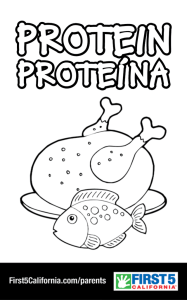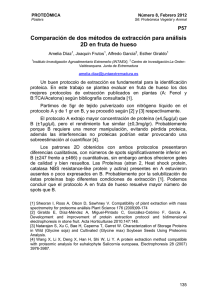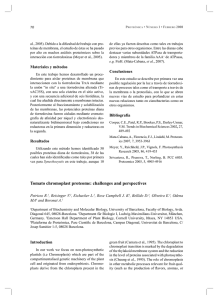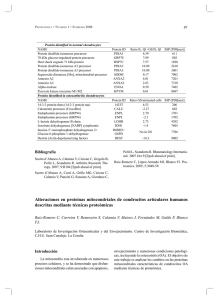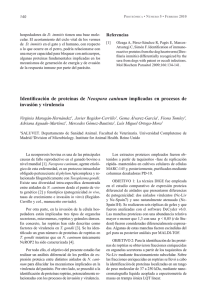pro46.pdf
Anuncio
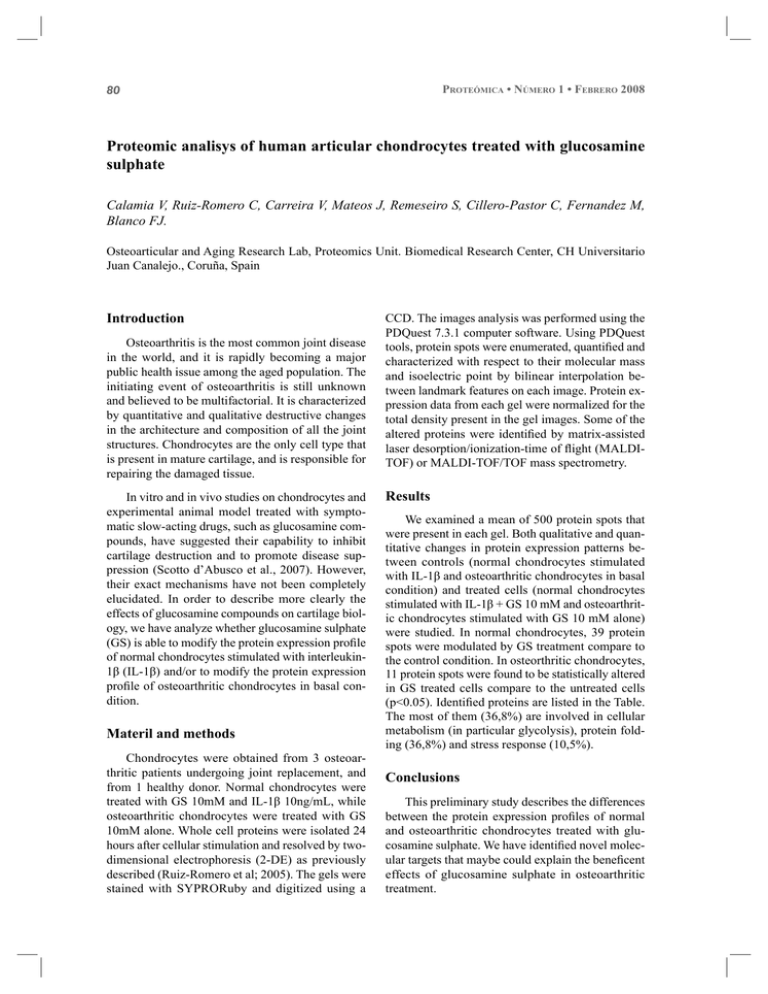
80 PROTEÓMICA • NÚMERO 1 • FEBRERO 2008 Proteomic analisys of human articular chondrocytes treated with glucosamine sulphate Calamia V, Ruiz-Romero C, Carreira V, Mateos J, Remeseiro S, Cillero-Pastor C, Fernandez M, Blanco FJ. Osteoarticular and Aging Research Lab, Proteomics Unit. Biomedical Research Center, CH Universitario Juan Canalejo., Coruña, Spain Introduction Osteoarthritis is the most common joint disease in the world, and it is rapidly becoming a major public health issue among the aged population. The initiating event of osteoarthritis is still unknown and believed to be multifactorial. It is characterized by quantitative and qualitative destructive changes in the architecture and composition of all the joint structures. Chondrocytes are the only cell type that is present in mature cartilage, and is responsible for repairing the damaged tissue. In vitro and in vivo studies on chondrocytes and experimental animal model treated with symptomatic slow-acting drugs, such as glucosamine compounds, have suggested their capability to inhibit cartilage destruction and to promote disease suppression (Scotto d’Abusco et al., 2007). However, their exact mechanisms have not been completely elucidated. In order to describe more clearly the effects of glucosamine compounds on cartilage biology, we have analyze whether glucosamine sulphate (GS) is able to modify the protein expression profile of normal chondrocytes stimulated with interleukin1β (IL-1β) and/or to modify the protein expression profile of osteoarthritic chondrocytes in basal condition. Materil and methods Chondrocytes were obtained from 3 osteoarthritic patients undergoing joint replacement, and from 1 healthy donor. Normal chondrocytes were treated with GS 10mM and IL-1β 10ng/mL, while osteoarthritic chondrocytes were treated with GS 10mM alone. Whole cell proteins were isolated 24 hours after cellular stimulation and resolved by twodimensional electrophoresis (2-DE) as previously described (Ruiz-Romero et al; 2005). The gels were stained with SYPRORuby and digitized using a CCD. The images analysis was performed using the PDQuest 7.3.1 computer software. Using PDQuest tools, protein spots were enumerated, quantified and characterized with respect to their molecular mass and isoelectric point by bilinear interpolation between landmark features on each image. Protein expression data from each gel were normalized for the total density present in the gel images. Some of the altered proteins were identified by matrix-assisted laser desorption/ionization-time of flight (MALDITOF) or MALDI-TOF/TOF mass spectrometry. Results We examined a mean of 500 protein spots that were present in each gel. Both qualitative and quantitative changes in protein expression patterns between controls (normal chondrocytes stimulated with IL-1β and osteoarthritic chondrocytes in basal condition) and treated cells (normal chondrocytes stimulated with IL-1β + GS 10 mM and osteoarthritic chondrocytes stimulated with GS 10 mM alone) were studied. In normal chondrocytes, 39 protein spots were modulated by GS treatment compare to the control condition. In osteorthritic chondrocytes, 11 protein spots were found to be statistically altered in GS treated cells compare to the untreated cells (p<0.05). Identified proteins are listed in the Table. The most of them (36,8%) are involved in cellular metabolism (in particular glycolysis), protein folding (36,8%) and stress response (10,5%). Conclusions This preliminary study describes the differences between the protein expression profiles of normal and osteoarthritic chondrocytes treated with glucosamine sulphate. We have identified novel molecular targets that maybe could explain the beneficent effects of glucosamine sulphate in osteoarthritic treatment. 81 PROTEÓMICA • NÚMERO 1 • FEBRERO 2008 Protein identified in normal chondrocytes NAME Protein disulfide-isomerase precursor 78 kDa glucose-regulated protein precursor Heat shock cognate 71 kDa protein Protein disulfide-isomerase A3 precursor Protein disulfide-isomerase A3 precursor Superoxide dismutase [Mn], mitochondrial precursor Annexin A2 Annexin A2 Alpha-enolase Pyruvate kinase isozymes M1/M2 Protein identified in osteoarthritic chondrocytes NAME 14-3-3 protein theta (14-3-3 protein tau) Calumenin precursor (Crocalbin) Endoplasmin precursor (GRP94) Endoplasmin precursor (GRP94) L-lactate dehydrogenase B chain Isocitrate dehydrogenase [NADP] cytoplasmic Inosine-5’-monophosphate dehydrogenase 2+ Glucose-6-phosphate 1-dehydrogenase Destrin (Actin-depolymerizing factor) Bibliografía Scotto d’Abusco A, Calamia V, Cicione C, Grigolo B, Politi L, Scandurra R. Arthritis Research Therapy. 2007; 9:R104 [Epub ahead of print]. Protein ID PDIA1 GRP78 HSP7C PDIA3 PDIA3 SODM ANXA2 ANXA2 ENOA KPYM Ratio IL-1β +GS/IL-1β 6.39 7.89 7.57 10.89 10.00 0.17 4.01 2.63 0.50 0.61 SSP (PDQuest) 611 802 1820 2610 3601 7002 7201 7210 7402 8607 Protein ID 1433T CALU ENPL ENPL LDHB IDH1 IMDH2+ G6PD DEST Ratio GS/untreated cells SSP (PDQuest) 6.53 206 -2.27 602 2.70 1701 -2.1 1702 2.73 4302 -1.4 7605 No in GS 7706 -14.3 9002 Politi L, Scandurra R. Rheumatology International. 2007 Oct 9 [Epub ahead of print]. Ruiz-Romero C, López-Armada MJ, Blanco FJ. Proteomics. 2005; 5:3048-59. Scotto d’Abusco A, Corsi A, Grillo MG, Cicione C, Calamia V, Panzini G, Sansone A, Giordano C, Alteraciones en proteínas mitocondriales de condrocitos articulares humanos descritas mediante técnicas proteómicas Ruiz-Romero C, Carreira V, Remeseiro S, Calamia V, Mateos J, Fernández M, Galdo F, Blanco FJ. Laboratorio de Investigación Osteoarticular y del Envejecimiento. Centro de Investigación Biomédica, C.H.U. Juan Canalejo. La Coruña Introducción La mitocondria esta involucrada en numerosos procesos celulares, y se ha demostrado que disfunciones mitocondriales están asociadas con apoptosis, envejecimiento y numerosas condiciones patológicas, incluyendo la osteoartritis (OA). El objetivo de este trabajo es analizar los cambios en las proteínas mitocondriales características de condrocitos OA mediante técnicas de proteómica.
